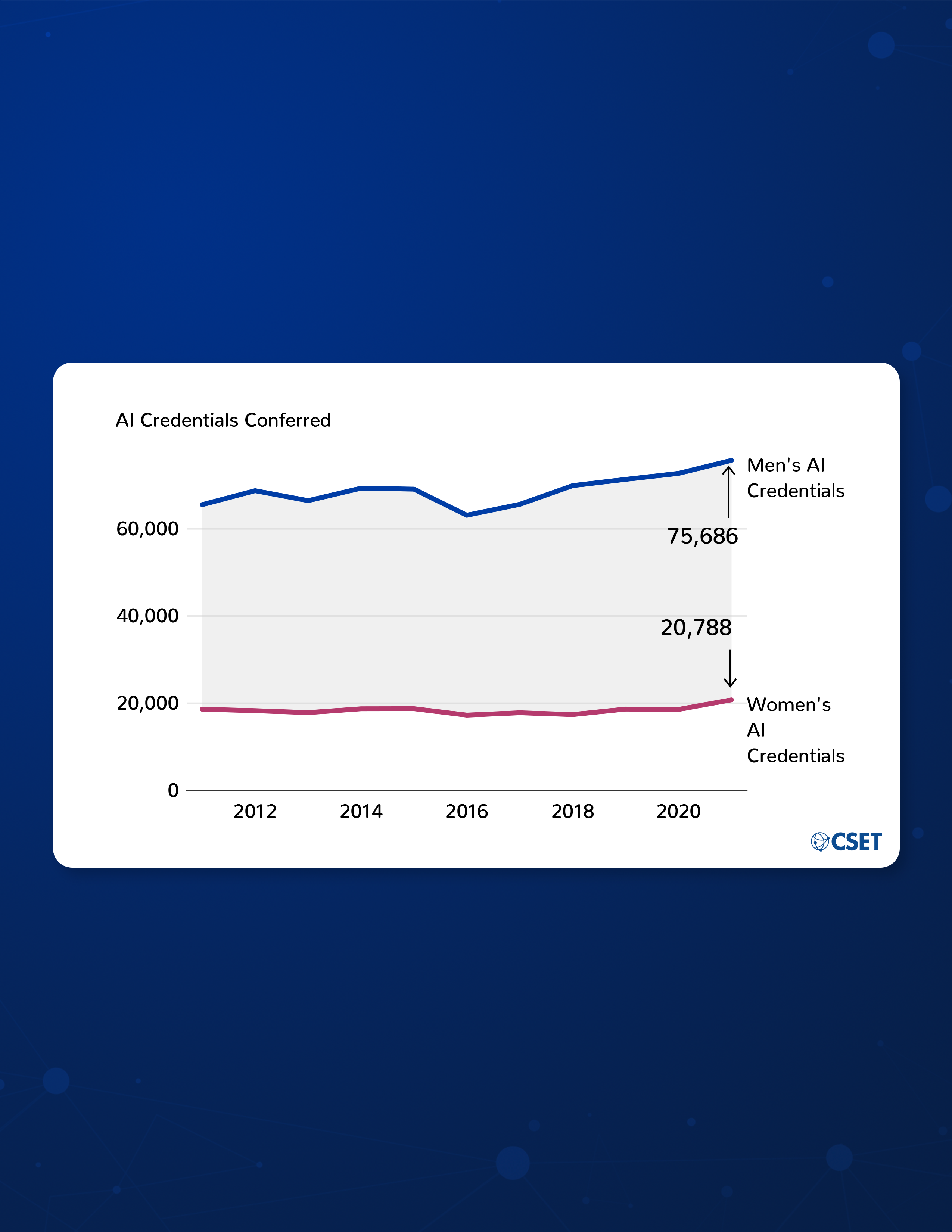This third snapshot in CSET’s Education series examines women’s representation in AI-related post-secondary degrees. Women’s underrepresentation in technology-related fields, particularly in those associated with AI, is well-documented in popular press, industry reports, and research.1 This phenomenon extends from workforce representation to education; the gender disparity is particularly stark considering that overall, women obtain more post-secondary degrees than men.
This snapshot will assess trends in AI-related pre-baccalaureate credentials (find an overall analysis of such trends here) and degrees over time for women and men (read more about AI-related degrees here). First, we compare conferral rates for men and women in AI-related non-degree certificates, bachelor’s degrees, master’s degrees, and doctoral degrees across all universities. We then analyze the top AI-related degree-conferring institutions for men and women for bachelor’s and master’s degrees to find whether the top universities conferring AI-related degrees differ by gender.
The analysis used Integrated Postsecondary Education Data System (IPEDS) data on degree conferrals in the United States and considers computer science, data science, human-computer interaction, bioinformatics, computer engineering, industrial engineering, nanotechnology, and cybersecurity to be AI-related majors. With IPEDS data, our data is limited to government statistics and does not include information about genders other than the male and female categories.
Conferred Pre-Baccalaureate Credentials for Men and Women
As Figure 1 shows, women earn more pre-baccalaureate credentials than men. The gap between men and women in pre-baccalaureate conferrals has remained approximately the same over time, with women earning 1.6 pre-baccalaureate awards for every one that men earned. However, men earned about two to three times as many STEM pre-baccalaureate awards than women, with the proportion of women earning STEM pre-baccalaureate awards compared to men increasing over time.2 In 2011, men earned 2.8 STEM pre-baccalaureate awards for every one STEM pre-baccalaureate award women earned; by 2021, men earned 2.1 STEM pre-baccalaureate awards for every one STEM pre-baccalaureate award women earned.
Figure 1. Total and STEM Pre-Baccalaureate Credentials for Men and Women
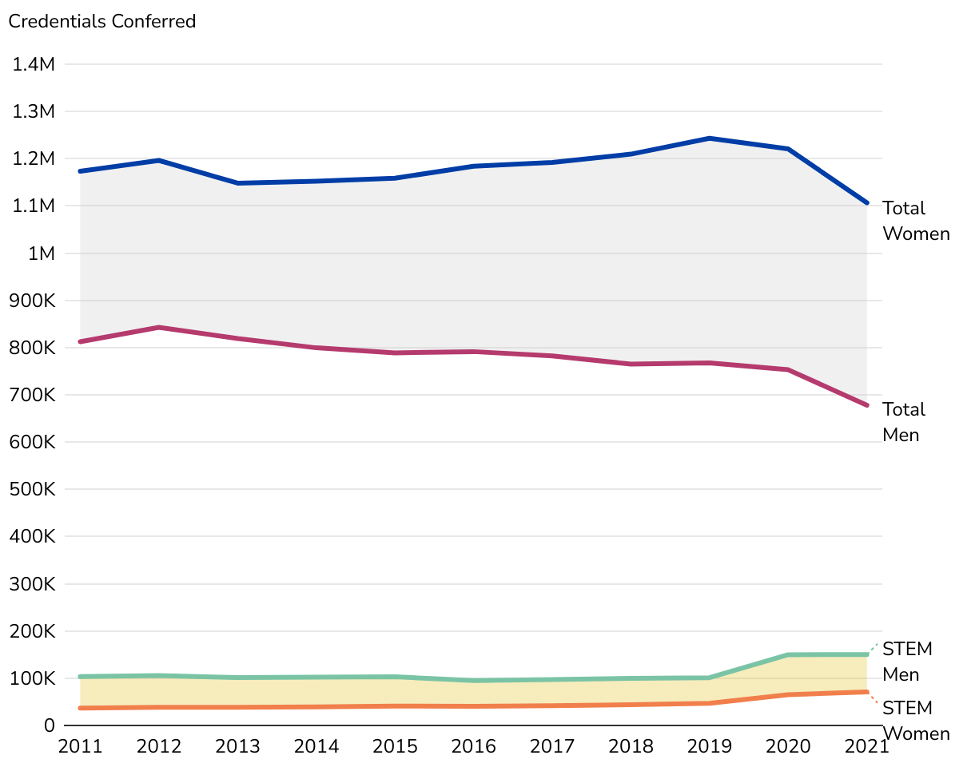
Examining AI-related credentials, as visualized in Figure 2 below, men earned substantially more AI-related credentials than women, a gap that has increased over the past decade. In 2011, men earned 3.5 AI-related pre-baccalaureate credentials for every one that women earned; by 2021, the disparity increased to 3.6 AI-related pre-baccalaureate credentials for every one that women earned.3 The gap between men and women with regard to AI-related credentials is wider than both the gaps between total credential conferrals and STEM credential conferrals.
The gap between men and women with regard to AI-related credentials is wider than both the gaps between total credential conferrals and STEM credential conferrals.
Figure 2. AI Pre-Baccalaureate Credentials for Men and Women
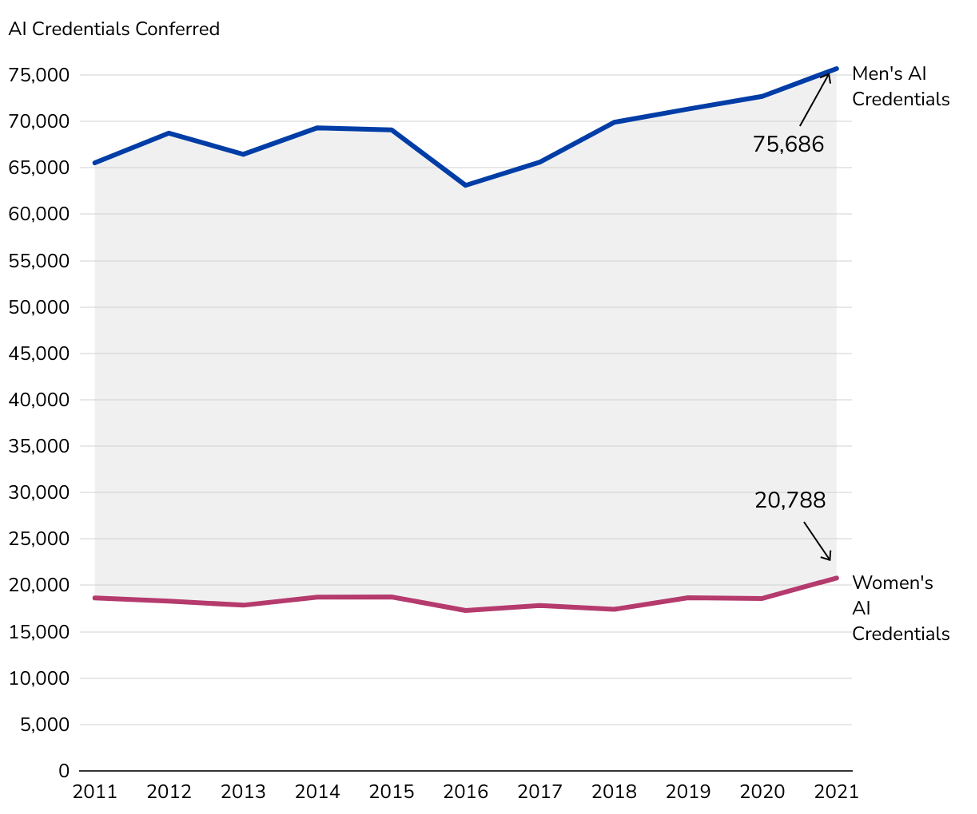
Bachelor’s and Master’s Attainment for Men and Women
At the bachelor’s and master’s levels, women account for an increasingly large proportion of degrees conferred. These gaps have widened over time, with women earning 1.4 bachelor’s degrees for every bachelor’s degree earned by men by 2021, up from 1.3 in 2010. Women earned 1.6 master’s degrees for each earned by men by 2021, up from 1.5 in 2010. This widening gap is in part due to growth in women’s degree conferrals over the past decade, while men’s degree conferrals have grown much more slowly, as displayed in Figure 3 below.
Figure 3. Total Bachelor’s and Master’s Degrees Conferred to Men and Women
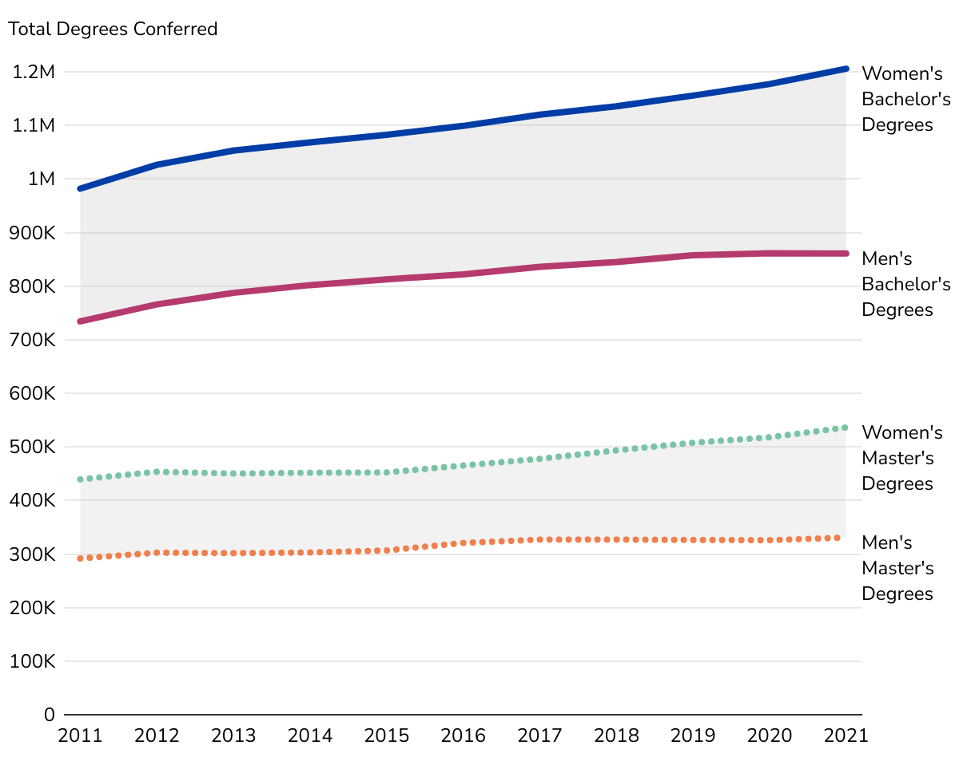
Women’s lead over men in bachelor’s and master’s degree earnings do not hold for STEM degrees. Men earn more STEM bachelor’s and master’s degrees; the gaps in both bachelor’s and master’s degrees have increased in absolute numbers, but decreased in ratios. For every STEM bachelor’s or master’s degree a woman earned in 2021, men earned 1.4 STEM bachelor’s or master’s degrees. In 2011, men earned 1.6 STEM bachelor’s degrees for every STEM bachelor’s degree earned by women and 1.8 STEM master’s degrees for every STEM master’s degree women earned. The absolute gap between men and women in combined annual STEM bachelor’s and master’s degrees conferrals increased from 104,697 more STEM degrees awarded in 2011 to 121,582 in 2021.
Figure 4. STEM Bachelor’s and Master’s Degrees Conferred to Men and Women
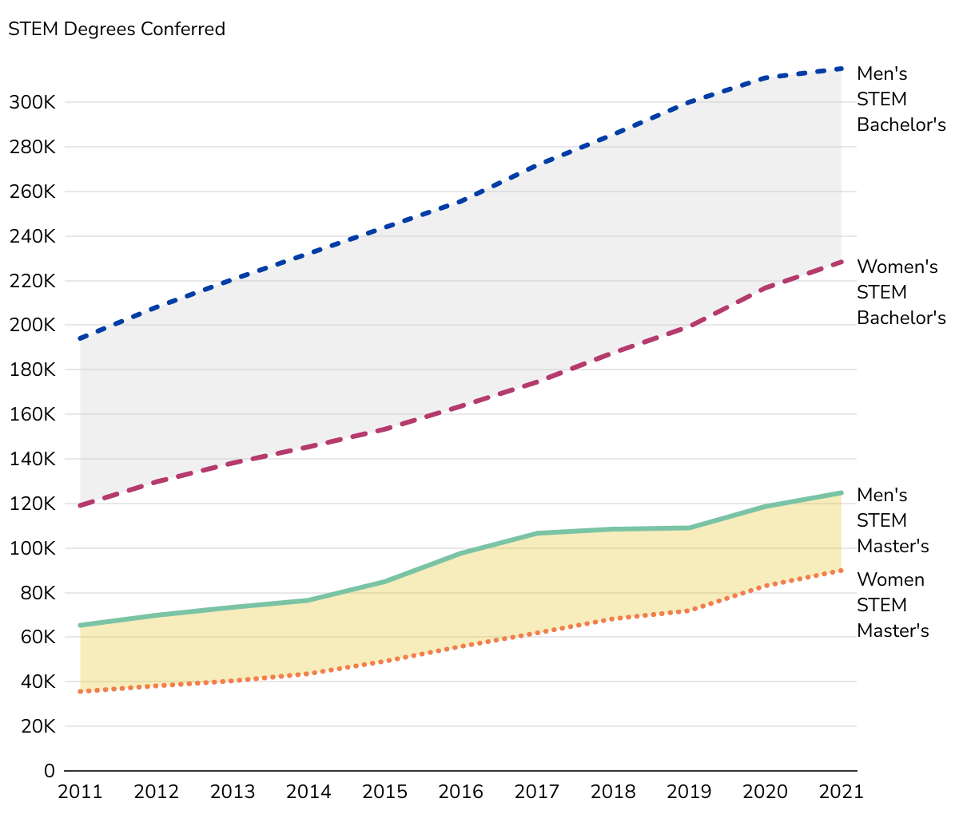
Similar to STEM, when examining AI-related fields, we found that men earn more AI degrees than women despite earning fewer degrees overall.4 The gaps between men and women earning AI-related bachelor’s and master’s degrees are far wider than the gaps between women and men earning any bachelor’s and master’s degrees, respectively. The gaps in AI degree conferrals for men and women are also materially wider, by almost three-fold, than the gaps in STEM degree conferrals.
Similar to STEM, when examining AI-related fields, we found that men earn more AI degrees than women despite earning fewer degrees overall.
As Figure 5 shows below, men earn more AI-related master’s degrees than women do AI-related bachelor’s degrees. This finding is counterintuitive, given that men’s rates of general master’s conferrals are much lower than women’s and that master’s degree conferrals tend to be lower than undergraduate degree conferrals. Still, these broad patterns are consistent with other researchers’ findings in computer science specifically.5 Consequently, a higher proportion of men who earn bachelor’s or master’s degrees pursued AI-related fields than women and a larger share of AI-related bachelor’s and master’s degrees are earned by men.
Figure 5. AI-Related Bachelor’s and Master’s Degrees Conferred to Men and Women

However, the gender gap between men and women earning AI-related bachelor’s and master’s degrees shrunk for both degree types. In 2011, men earned five AI-related bachelor’s degrees for every one AI-related bachelor’s degree women earned, while in 2021, men earned four AI-related bachelor’s degrees for every AI-related bachelor’s degree women earned. For master’s degrees, in 2010 men earned three AI-related degrees for every one AI-related master’s degree women earned, while in 2021, men earned two AI-related master’s degrees for every AI-related master’s degree women earned.
Still, note that in absolute numbers, the gap between men and women has increased dramatically for both bachelor’s and master’s AI-related degrees. For bachelor’s degrees, the annual conferral gap between men and women widened from 44,716 degrees to 84,064 degrees; for master’s degrees, the gap widened from 17,105 degrees in 2011 to 26,329 in 2021.
We additionally examined the top AI-related bachelor’s degree–conferring institutions by gender. Most of the top-25 institutions (described in more detail in Snapshot 1) had gender disparities on par with national trends since 2015, with a few exceptions. Cornell University and Massachusetts Institute of Technology (MIT) had the smallest gender gaps in AI-related bachelor’s conferrals (men earned 1.8 degrees at Cornell and 1.6 degrees at MIT for each degree earned by women). Western Governors University (WGU), a primarily virtual institution, had by far the widest gender gap in degree conferrals in AI-related fields, with men earning nearly 11 times as many AI-related bachelor’s degrees as women. WGU also confers the highest number of AI-related Bachelor’s degrees in the country.
The top AI-related master’s degree–conferring institutions generally had narrower gaps than the top AI-related bachelor’s degree–conferring institutions. On average, the top AI-related master’s degree–conferring institutions conferred twice as many AI-related degrees to men than to women. The Georgia Institute of Technology and Campbellsville University in Kentucky had the widest gaps and conferred between three to four times as many AI-related master’s degrees to men as to women. Grand Canyon University in Arizona and the Academy of Art University in California (the latter confers master’s degrees in topics like industrial design, game development, and user interaction) actually conferred twice as many AI-related master’s degrees to women as to men.
Overall, including doctorates described in the next section, four universities–Carnegie Mellon, Cornell, Columbia, and the University of Washington–all had smaller-than-average gender gaps (less than twice as many AI-related degrees went to men), while WGU had a much larger gap than average (more than eight AI-related degrees went to men for each AI-related degree conferred to women).
PhD Attainment for Men and Women
There was no difference between general research doctorate attainment between men and women over the past decade.6 This lack of disparity is in contrast to bachelor’s, master’s, and pre-baccalaureate credentials, where women tend to earn more degrees and credentials than men.
Figure 6. All-Subject and STEM PhD Attainment for Men and Women
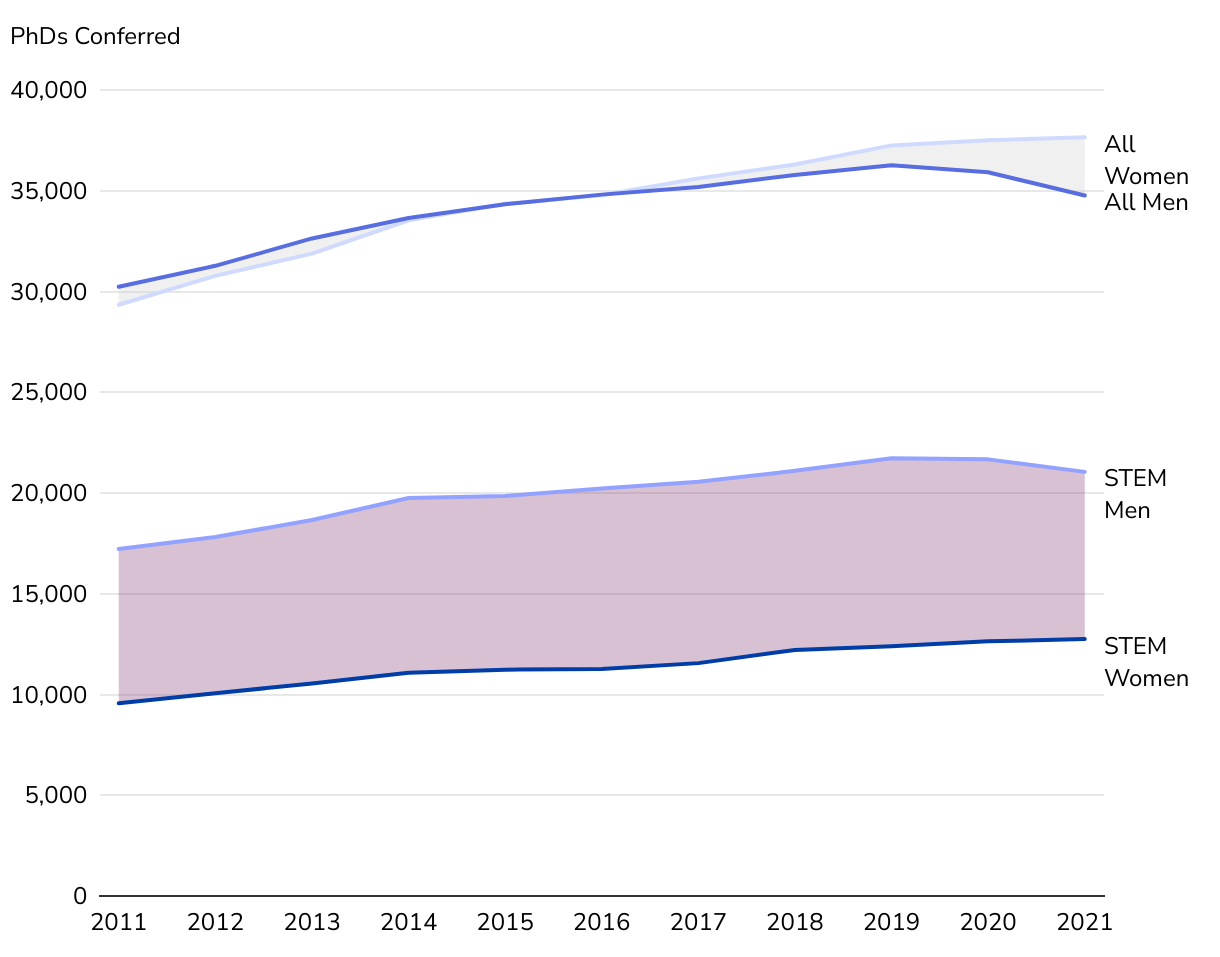
Nonetheless, men earned more STEM research doctorates than women over the past decade. In 2021, men earned 1.7 STEM PhDs for each STEM PhD earned by women, a slightly narrowed ratio from 1.8 to one in 2011, as visualized in Figure 6 above.
As in the other AI-related degree award types, men earn more AI research doctorates than women, and that gap is widening in absolute numbers but shrinking in ratios. The patterns in AI PhD attainment in men and women since 2011 are visualized below in Figure 7. In 2011, men earned four times as many AI-related research doctorates as women. By 2021, men earned more than three times as many AI-related research doctorates as women; this decrease is attributed to slightly faster growth in women’s attainment of AI-related research doctorates than men. The gaps between men and women in AI-related PhD conferrals are larger than the gaps between men and women in STEM-related PhD conferrals.
Figure 7. AI PhD Attainment for Men and Women
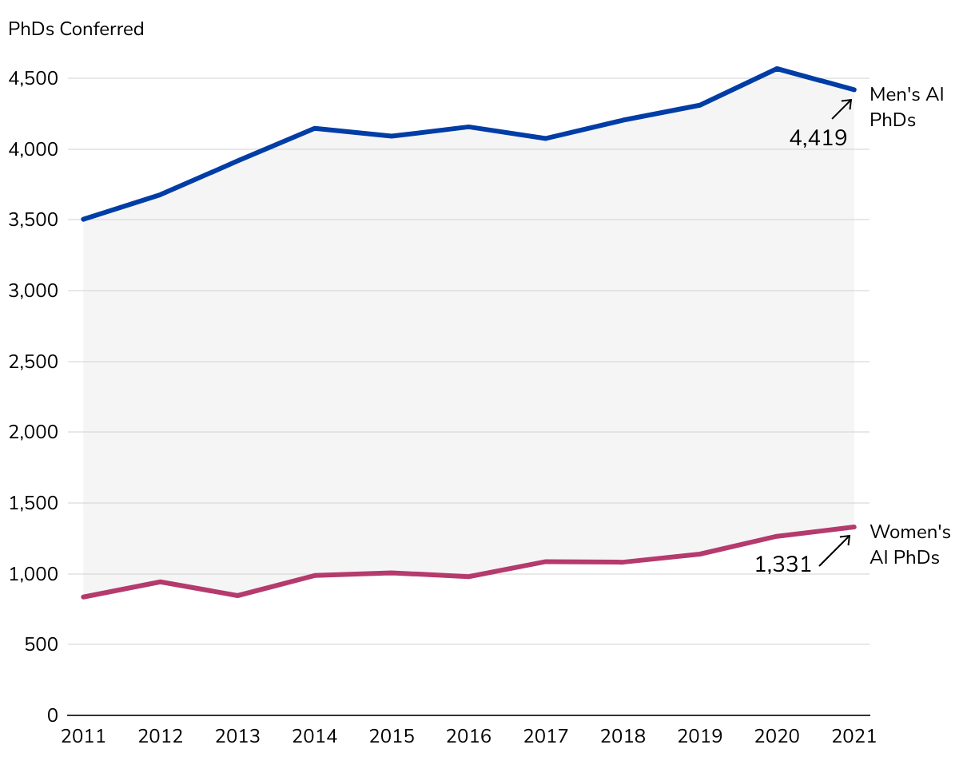
Most of the 25 AI-related doctorate-conferring institutions had wide gender gaps in AI-related fields, as expected. The University of Washington, Capella University, and Nova Southeastern University in Florida had the narrowest gaps, each conferring about twice as many AI-related doctorate degrees to men as to women.
Conclusion
After examining women’s shares of AI-related pre-baccalaureate, undergraduate, master’s, and doctoral awards, we found that women comprise a minority of AI-related awards despite earning significantly more awards and degrees than men across all fields. Most of the top-25 AI-related degree-conferring institutions have gender gaps comparable to national gender gaps in AI, with a few exceptions.
However, we also found that gaps between men’s and women’s AI-related educational attainments are proportionally shrinking as women’s growth in AI-related fields increases faster than men’s growth in the same fields. Still, absolute gaps in the number of degree conferrals—rather than ratios between men’s and women’s degree conferrals—are increasing over time. This dynamic may lead to bigger gender imbalances in the workplace as AI-related careers comprise a higher percentage of all jobs.
In the next CSET Education snapshot, we will examine AI-related graduation totals for Black students and at historically Black colleges and universities (HBCUs).
- E.g., https://newsroom.ucla.edu/stories/cracking-the-code:-why-aren-t-more-women-majoring-in-computer-science
- We use STEM degree classifications from the Department of Homeland Security. See https://www.ice.gov/doclib/sevis/pdf/stemList2022.pdf for the current list of qualifying majors.
- We did not compare the top institutions where men and women earned AI-related pre-baccalaureate credentials, because the many factors that go into choosing institutions to complete pre-baccalaureate credentials may involve less recruitment and retention than when completing degrees at four-year universities. E.g., https://www.frontiersin.org/articles/10.3389/fpsyg.2022.918439/full, https://mccourt.georgetown.edu/news/complex-reasons-spur-women-to-change-stem-majors-new-georgetown-study-finds/, and https://www.sciencedirect.com/science/article/abs/pii/S0191886922000356.
- Consistent with other researchers’ findings in computer science. E.g., https://www.wired.com/story/computer-science-graduates-diversity/
- E.g., Pew Research https://www.pewresearch.org/science/2021/04/01/stem-jobs-see-uneven-progress-in-increasing-gender-racial-and-ethnic-diversity/
- Independent sample t-test, p = 0.80.
